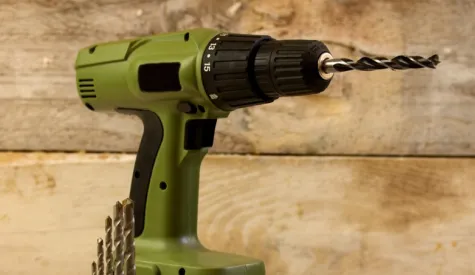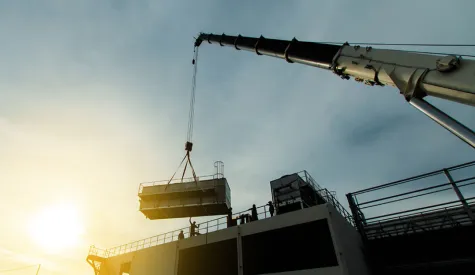Preventing Caught-in and Caught-between Incidents

Caught-in and caught-between injuries result when a worker gets squeezed, caught, crushed, pinched, or compressed between two or more objects or parts of an object. They are one of the “Focus Four Construction Hazards,” along with falls, electrocution, and struck-by accidents. These four hazards represent the most dangerous types of construction site accidents, and contribute most to fatal injuries.
(Which is important, because fatal injuries while on the job are on the rise: The Center for Construction Research and Training reported the number of fatal injuries in construction reached 1,102 in 2019, the highest level since before 2011. These tragedies are preventable, but only if everyone in the construction industry is committed to following all safety protocols on the construction site.)
It’s not hard to see how caught-in and caught-between accidents can occur: A piece of equipment with moving parts that is not safeguarded, heavy machinery that can tip over, and cave-ins of unprotected trenches and excavations can all lead to serious injury or death. That said, caught-in and caught-between incidents are often the direct result of negligence, improper procedures, or failure to adhere to safety regulations.
Caught-between Hazards on Construction Sites are Preventable, but still Happen
The “Construction Focus Four” hazards (as defined by OSHA) caused 709 deaths in 2019, or 64.3% of all construction fatalities that year. Fatal falls climbed to 401 in 2019, accounting for more than one in three (36.4%) construction deaths that year, a 25% increase compared to 2018. In contrast, the number and proportion of fatalities from struck-by incidents (170; 15.4%) and electrocutions (79; 7.2%) decreased from 2018 to 2019, while the number of fatalities due to caught-in/between incidents remained relatively constant.
That said, there were 142 caught-in and caught-between construction worker deaths nationwide in 2020, according to the Center for Construction Research and Training. Such accidents are also a leading cause of nonfatal injuries.
Common Caught-in and Caught-between Hazards
It does not take long to see that construction workers are at a high risk for being caught-in or -between equipment and/or stationary objects. An obvious case of a caught-in accident is being crushed by something, but there are many other ways you could become trapped between two things.
For example, you could fall into a machine while working on it and become trapped, or one or more body parts could become wedged into the machine. To be rescued and removed from the machine, another worker must be present.
Another possible scenario involves getting trapped in debris after an explosion at your construction site—you might not have time for an evacuation plan since most explosions happen very quickly.
How to Prevent Caught-in and Caught-between Injuries Before they Happen
OSHA's Quick Card for the Top Four Construction Quick Hazards explains that preventing such incidents is more effective when construction workers follow best practices:
- All employees should be trained on the safe operation of equipment, tools, PPE, and scaffolding. They also need to know how to use hoists safely.
- Employers should ensure that their employees are trained on the hazards associated with their job and what they can do if they get caught in or between something else while performing their duties. This will help them prevent future incidents involving this type of injury.
- Never enter an unprotected trench or excavation 5 feet or deeper without adequate protective systems; some trenches under 5 feet deep may also need such a system.
- Ensure the trench or excavation is protected by sloping, shoring, benching, or trench shield systems.
Beyond these tips, there is even more that a safety officer or safety team can do to ensure that these kinds of accidents rarely, if ever, happen.
1) Commit to Following all Safety Protocols on the Construction Site
Everyone on the construction site must be committed to safety to prevent caught-in and caught-between incidents. Everyone needs to work together as a team. When this happens, it will be easier for them to follow all of the rules established by their employer or supervisor, and they can communicate with each other effectively when there are problems. If all of these things happen, you can be sure that no one will become injured while working on your construction project because they were either too distracted or did not know enough about what was happening around them at the time of the accident.
OSHA requires employers to protect workers from struck-by hazards. Employers are required to:
- Meet all heavy equipment, motor vehicle, and general requirements included in OSHA construction standards
- Provide proper PPE, like wearing high-visibility clothes near equipment/vehicles
- Provide required training for equipment and vehicles
- Ensure qualification of operators, riggers, signal persons, and competent persons
2) Inspect Equipment Daily for Safety
Inspecting equipment daily for safety issues isn’t just a smart safety practice, it’s an OSHA regulation.
If you have new employees, inspecting your equipment before use is even more critical. Inspections include checking that all moving parts are in good condition, no exposed sharp edges or loose bolts exist on the machine, and that all protective devices, such as guarding, are correctly installed. It's also important to check that any guards used are working correctly (for example, they should be able to move freely without binding).
You should also check your equipment regularly once it has been put into use by thoroughly inspecting all components at least every six months after initial installation. Also, inspection after maintenance has occurred on a component—and more often, if necessary, due to wear and tear or exposure to harsh environmental conditions like dust or chemicals.
3) Perform Frequent, Unannounced Spot-Checks of Operations
Ways to conduct a spot-check include:
- Observing operators' behaviors and actions during their shifts.
- Questioning construction workers about their tasks and responsibilities, especially when unusual circumstances are present (for example, when there is a potential "caught-between" situation).
- Watching how equipment, tools, or machines are used during the regular operation to ensure safe practices are followed (for example, having only one worker on a machine at one time).
Unannounced spot-checks of operations are an essential tool for safety. Supervisors or managers can perform them, but ideally these spot-checks should be done by people other than the person supervising the construction workers so that they are more educational than punitive. You will want workers to learn from these inspections, not feel like they are being punished for doing something wrong.
4) Conduct Routine "Toolbox Meetings" with Employees to Provide Updates on Safety Compliance Matters
One effective training method is toolbox meetings, where workers participate in 10- to 15-minute instructional sessions to learn the hazards associated with their work as well as the safety steps they can take to prevent incidents from occurring.
These kinds of meetings help complement your organization’s safety training program, and along with official written policies, help to communicate potential workplace hazards and the OSHA regulations designed to prevent them.
Help keep your construction workers safe and your company compliant with our construction safety training.


